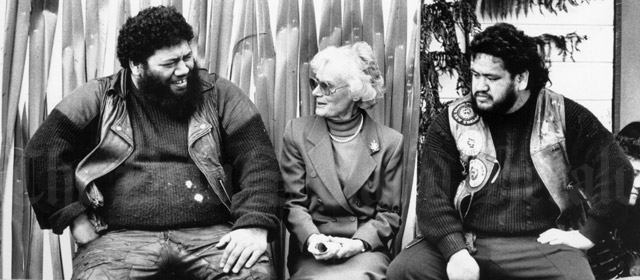Story summary
Bike gangs
Men have always banded together for brotherhood, friendship or joint enterprise. In the late 1940s bored young returned soldiers formed motorcycle gangs in California. Their antics were publicised by movies and pop music, and when these reached New Zealand, copycat gangs were formed.
Young men who felt left out of mainstream society were drawn to the gangs. Gang members said they got together to ride their bikes, but some also became involved in crime.
White supremacists
From the 1970s small numbers of Pākehā men formed white-supremacy groups. They often wore boots and shaved their heads, and were known as boot boys or skinheads. They have been involved in attacks on New Zealanders of other ethnicities and on gay men.
Māori and Pacific Island gangs
In the 1970s young Māori men joined gangs like the Mongrel Mob, Black Power and the Nomads. The Mongrel Mob is New Zealand’s largest gang – in 2018 it had over 1,000 members. These gang members wear patches on their jackets, and often have gang tattoos on their bodies and faces.
Young Pacific Islanders formed the King Cobras in the late 1950s. In the early 2000s some Pacific Island gangs mimicked Los Angeles street gangs, adopting their colours and behaviour. These gangs are sometimes known as 'homie' gangs.
Gangs and crime
Gangs have engaged in inter-gang brawls, murder and rape. Men who want to join a gang often undergo beatings and have to commit crimes to prove their commitment. Gangs which deal in drugs sometimes discourage other crimes in to protect their business. In recent years gang rape has been banned in many gangs, although individual members still sometimes commit rape.
In the 1980s police discovered New Zealand links to Asian crime networks and Chinese triads based in Hong Kong, Macau and mainland China. Triad-like gangs and other organised Asian crime groups have been associated with offences like extortion and kidnapping, and smuggling drugs and pāua.
Gangs and society
In 1954 the government set up a special committee to investigate youth delinquency. Other groups over the years have studied youth crime, with little effect on young people’s behaviour.
In the early 1980s, Prime Minister Robert Muldoon set up schemes in which gangs were paid to do contract work, to stop them getting involved in crime. Some gangs abused the work schemes, using the money to attract new members and do up their headquarters. Because of this, the schemes ended in 1987.
There is a variety of opinion about the best way to deal with gangs. Some experts say the best way to stop gang crime is to prevent young people getting mixed up with gangs, provide useful activities for gang members, and outlaw some gang behaviours.
Laws have been passed to give police more power to deal with gangs and to confiscate the assets of people who have made money through criminal behaviour.
In 2009 gang members were banned from wearing their patches in Whanganui, but his bylaw was later overturned. In 2013 a law banning gang regalia from public premises such as schools, swimming pools and government buildings was passed.
In 2020 there were thought to be more than 7000 patched gang members in New Zealand.





